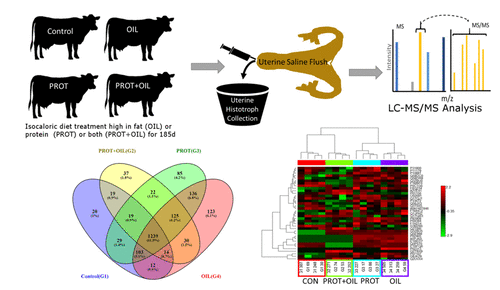当前位置:
X-MOL 学术
›
J. Proteome Res.
›
论文详情
Our official English website, www.x-mol.net, welcomes your feedback! (Note: you will need to create a separate account there.)
Diet Impacts Pre-implantation Histotroph Proteomes in Beef Cattle
Journal of Proteome Research ( IF 4.4 ) Pub Date : 2018-05-18 , DOI: 10.1021/acs.jproteome.8b00077 KaLynn Harlow , Emily Taylor , Theresa Casey , Victoria Hedrick , Tiago Sobreira , Uma K. Aryal , Ronald P. Lemenager , Bethany Funnell , Kara Stewart
Journal of Proteome Research ( IF 4.4 ) Pub Date : 2018-05-18 , DOI: 10.1021/acs.jproteome.8b00077 KaLynn Harlow , Emily Taylor , Theresa Casey , Victoria Hedrick , Tiago Sobreira , Uma K. Aryal , Ronald P. Lemenager , Bethany Funnell , Kara Stewart

|
In ruminants, the period from fertilization to implantation is relatively prolonged, and the survival of embryos depends on uterine secretions known as histotroph. Our objective was to determine if the pre-breeding diet affected histotroph proteomes in beef cattle. Cows were assigned to one of four diets: a control diet (CON), a high-protein diet (PROT), a high-fat diet (OIL), or a high-protein and high-fat diet (PROT + OIL). After 185 days on these diets, an intravaginal progesterone implant (CIDR) was inserted for 7 days. At 9 days after CIDR removal, animals with a corpus luteum were selected (n = 16; 4 per treatment). Proteins were isolated from the histotroph collected by uterine lavage and analyzed with liquid chromatography–tandem mass spectrometry. Over 2000 proteins were expressed (n ≥ 3 cows per treatment), with 1239 proteins being common among all of the groups. There were 20, 37, 85, and 123 proteins unique to CON, PROT + OIL, PROT, and OIL, respectively. Relative to CON, 23, 14, and 51 proteins were differentially expressed in PROT + OIL, PROT, and OIL, respectively. Functional analysis found that 53% of histotroph proteins were categorized as extracellular exosome, 3.28% as cell–cell adhesion, and 17.4% in KEGG metabolic pathways. Differences in proteomes among treatments support the idea that pre-breeding diet affects histotroph. Understanding the impact of diet on histotroph proteins may help improve conception rates.
更新日期:2018-05-19



























 京公网安备 11010802027423号
京公网安备 11010802027423号